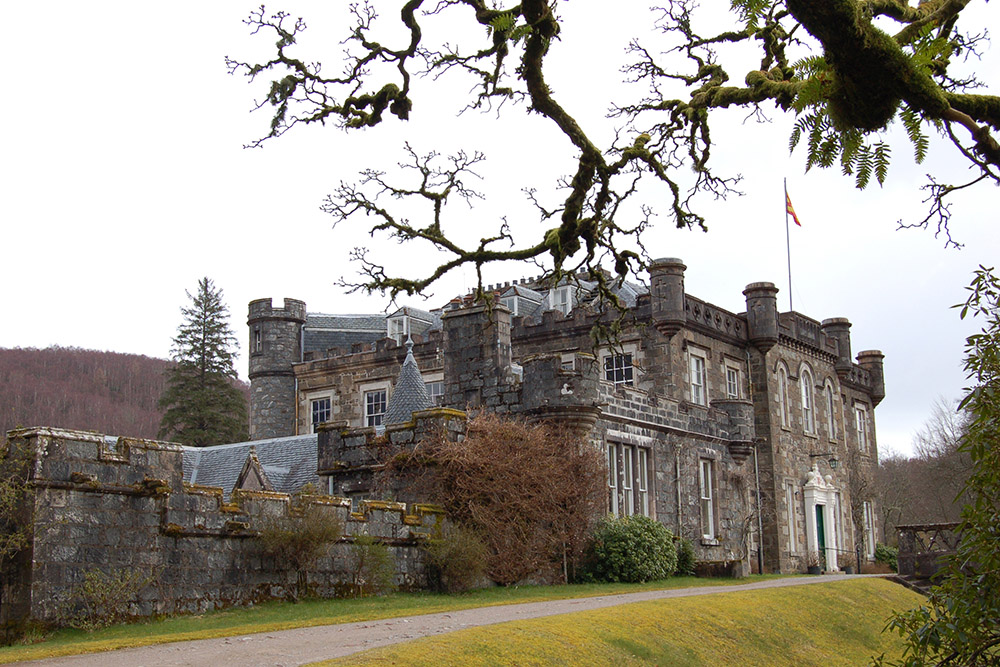Achnacarry Castle
Achnacarry Castle, seat of Clan Cameron in the Scottish Highlands, has a history marked by destruction, rebuilding, and global significance. Built in 1655, it was burned after Culloden in 1746, rebuilt in 1802, and later became famous as the Commando Training Depot during the Second World War.
The original castle was constructed by Sir Ewen Cameron of Lochiel in 1655 on a strategic isthmus between Loch Lochy and Loch Arkaig. It became the clan’s stronghold until the Jacobite Rising of 1745–46. After the defeat at Culloden, government troops under the Duke of Cumberland destroyed Achnacarry, leaving it in ruins for more than fifty years.
In 1802, Donald Cameron, the 22nd Chief, rebuilt the residence in the Scottish Baronial style, creating what is still known as “New Achnacarry.” The estate remained the symbolic heart of Clan Cameron, visited by figures such as Queen Victoria, who admired its dramatic setting.
Achnacarry also played a role in global economic history: in 1928 it hosted the signing of the Achnacarry Agreement, an early attempt by major oil companies to regulate petroleum production and markets.
During the Second World War, Achnacarry Castle became one of the most famous military training sites in the world: the Commando Basic Training Centre, where more than 25,000 Allied soldiers—including British Commandos, U.S. Army Rangers, and volunteers from occupied Europe—underwent some of the harshest and most innovative training of the war.
When Winston Churchill called for the creation of elite raiding forces in 1940, the Highlands of Scotland were chosen as the ideal setting. In 1942, Achnacarry Castle and its surrounding estate were transformed into the Commando Depot, later renamed the Commando Basic Training Centre (CBTC). Under the command of Lieutenant Colonel Charles Vaughan, the centre quickly gained a reputation as the toughest training ground in the Allied world.
The training was deliberately designed to be brutal and uncompromising. Recruits were subjected to forced marches over the rugged Highland terrain, live-fire exercises where bullets and explosives were used to simulate battlefield conditions, and relentless physical conditioning. The “Achnacarry speed march”—a seven-mile run carrying full kit and weapons—became legendary. Many men failed to complete the course, but those who did earned the coveted green beret and the right to call themselves Commandos.
The CBTC was not limited to British troops. American Rangers, Free French, Dutch, Belgian, Norwegian, Polish, and even Free German volunteers trained at Achnacarry, making it a uniquely international crucible of resistance against Nazi occupation. The methods pioneered there influenced special forces training worldwide, setting the template for modern commando and ranger units.
The impact of Achnacarry’s training was felt across the war. Commandos trained there took part in raids on the French coast, operations in Norway, the Dieppe Raid, and later spearheaded the landings in Sicily, Italy, and Normandy. U.S. Rangers, who trained alongside their British counterparts, carried the lessons of Achnacarry into their assaults at Pointe du Hoc on D-Day. Veterans often recalled that the hardships of combat seemed less daunting after enduring the rigors of the Scottish Highlands.
By the time the centre closed in 1945, tens of thousands of men had passed through its gates, and its reputation was such that “Achnacarry” became synonymous with toughness, endurance, and elite soldiering. Today, the Commando Memorial at nearby Spean Bridge stands as a tribute to those who trained and fought, while the Clan Cameron Museum preserves the story of the castle’s wartime role.
Today, Achnacarry remains the private home of the Cameron family. While the castle itself is not open to the public, the nearby Clan Cameron Museum and the Commando Memorial at Spean Bridge preserve its legacy as both a clan seat and a symbol of Allied resistance in the Second World War
Do you have more information about this location? Inform us!
Source
- Text: TracesofWar
- Photos: Keeshu




